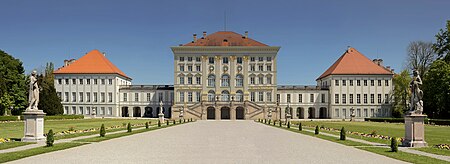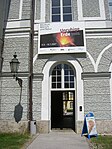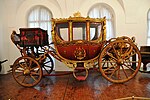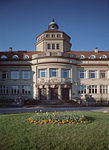Nymphenburg Palace
1675 establishments in the Holy Roman EmpireBaroque architecture in MunichBaroque palaces in GermanyBuildings and structures in MunichHeritage sites in Bavaria ... and 9 more
Historic house museums in GermanyHouses completed in 1675Museums in MunichOlympic equestrian venuesPalaces in BavariaProtected areas of BavariaRoyal residences in BavariaTourist attractions in MunichVenues of the 1972 Summer Olympics

The Nymphenburg Palace (German: Schloss Nymphenburg, Palace of the Nymphs) is a Baroque palace situated in Munich's western district Neuhausen-Nymphenburg, in Bavaria, southern Germany. Combined with the adjacent Nymphenburg Palace Park it constitutes one of the premier royal palaces of Europe. Its frontal width of 632 m (2,073 ft) (north-south axis) even surpasses Versailles Palace. The Nymphenburg served as the main summer residence for the former rulers of Bavaria of the House of Wittelsbach.
Excerpt from the Wikipedia article Nymphenburg Palace (License: CC BY-SA 3.0, Authors, Images).Nymphenburg Palace
Nördliches Schloßrondell, Munich Nymphenburg
Geographical coordinates (GPS) Address Website External links Nearby Places Show on map
Geographical coordinates (GPS)
| Latitude | Longitude |
|---|---|
| N 48.158056 ° | E 11.503611 ° |
Address
Schloss Nymphenburg
Nördliches Schloßrondell 1
80638 Munich, Nymphenburg
Bavaria, Germany
Open on Google Maps









